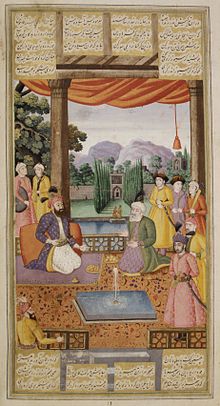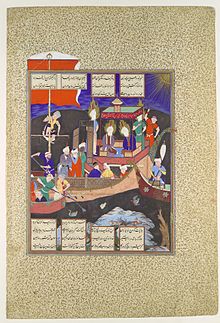Shahnameh: The Epic of the Persian Kings
https://iranwire.com/en/features/45
| The Book of Kings | |
| by Ferdowsi | |
 Bahram Gur and Courtiers Entertained by Barbad the Musician (from a manuscript in the Brooklyn Museum) | |
| Original title | شاهنامه |
|---|---|
| Written | 977–1010 CE |
| Country | Iran |
| Language | Classical Persian |
| Subject(s) | Persian mythology, history of Iran |
| Genre(s) | epic poem |
| Meter | Lines of 22 syllables with two rhyming couplets in the same metre (bahr-i mutaqarib-i mahzuf)[1] |
| Publication date | 1010 |
| Published in English | 1832 |
| Media type | manuscript |
| Lines | c. 50,000 depending on manuscript |
| Preceded by | Khwaday-Namag |
| Read online | "Shahnameh" at Wikisource |
The Shahnameh or Shahnama (Persian: شاهنامه, romanized: Šāhnāme pronounced [ʃɒːhnɒːˈme]; lit. ' 'The Book of Kings'')[a] is a long epic poem written by the Persian poet Ferdowsi for Sultan Mahmud of Ghazni[2] between c. 977 and 1010 CE and is the national epic of Greater Iran. Consisting of some 50,000 "distichs" or couplets (two-line verses),[3] the Shahnameh is one of the world's longest epic poems. It tells mainly the mythical and to some extent the historical past of the Persian Empire from the creation of the world until the Muslim conquest in the seventh century. Iran, Azerbaijan, Afghanistan, Tajikistan and the greater region influenced by Persian culture such as Armenia, Dagestan, Georgia, Turkey, Turkmenistan and Uzbekistan celebrate this national epic.[4]
The work is of central importance in Persian culture and Persian language, regarded as a literary masterpiece, and definitive of the ethno-national cultural identity of Iran.[5] It is also important to the contemporary adherents of Zoroastrianism, in that it traces the historical links between the beginnings of the religion and the death of the last Sasanian emperor, which brought an end to the Zoroastrian influence in Iran.
https://en.wikipedia.org/wiki/Shahnameh
維基百科 列王紀、
《諸王之書》,亦稱為《王書》、《列王書》、《諸王書》(波斯語:شاهنامه、Šāhnāmeh;即《諸王之書》),是波斯民族的史詩。《列王紀》由10世紀末及11世紀初期的著名波斯詩人菲爾多西用波斯文所著,長約6萬多聯押韻對句(共12萬多行),[1]記錄了從遠古神話時期到7世紀的波斯薩珊王朝滅亡這4000多年間的波斯帝國的神話傳說和歷史故事,以及50多位帝王的統治。這部史詩被稱為是波斯古代社會生活的百科全書,對波斯語言和文化在阿拉伯人統治時期能夠得以保存起了重要作用,是伊朗民族的文化認同中重要的一部份。[2]《列王記》不僅在波斯文學中具有重要地位,對中亞其他民族的文學也有明顯的影響。[3]
《列王紀》的插畫本是波斯細密畫最華麗的範例。最精美的版本是藏於大都會藝術博物館的霍頓版,是在16世紀初由伊朗王塔赫馬斯普下令製成的。[11]雖然有幾個《列王紀》插圖本是完整的,但最著名的兩個插圖本(霍頓版和大蒙古版)卻在20世紀被分成多頁出售。霍頓版的有一頁在2006被賣出過£904,000的高價。[12]泥金裝飾手抄本的Baysonghori版《列王紀》(伊朗古列斯坦皇宮)還被包括在UNESCO的世界記憶項目中的文化遺產部分。[13]大蒙古版《列王紀》是在伊兒汗國不賽因的統治時期製成的,是插圖最多的和最重要的版本之一。[14]
書 《列王紀選》(伊朗)菲爾多西 著,張鴻年 譯 (1991)





沒有留言:
張貼留言